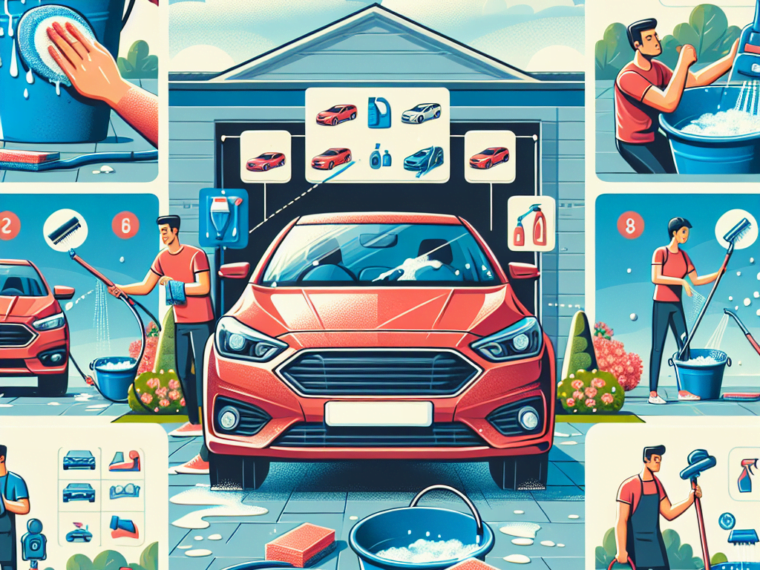I. Introduction
Maintaining a clean car is essential for both the appearance and the longevity of the vehicle. Regular car washing not only keeps the exterior looking shiny and new but also helps to protect the paint and finish from the damaging effects of dirt, grime, and environmental pollutants. Additionally, washing your car regularly can prevent the buildup of corrosive substances such as salt and bird droppings, which can cause damage over time. It also helps to maintain the value of the car, as a clean and well-maintained exterior is more attractive to potential buyers. Overall, the benefits of regular car washing include preserving the vehicle’s appearance, protecting its exterior surfaces, and maintaining its resale value.
II. Understanding the Basics
Understanding the Basics
Different types of car washes
When it comes to washing your car, there are several different options to consider. You can choose to hand wash your car at home, take it to a professional car wash, or use a self-service car wash. Each option has its own advantages and disadvantages, so it’s important to consider your specific needs and preferences before making a decision.
Tools and equipment needed for washing a car
Before you start washing your car, it’s important to gather all the necessary tools and equipment. This typically includes a bucket, car wash soap, a sponge or wash mitt, a hose, and a microfiber towel for drying. Additionally, you may also need a wheel brush, a vacuum cleaner for the interior, and a wax or polish for the finishing touch.
Choosing the right cleaning products
When it comes to choosing the right cleaning products for your car, it’s important to consider the specific needs of your vehicle. Look for a high-quality car wash soap that is gentle on the paint and won’t strip away any wax or sealant. Additionally, consider using a separate wheel cleaner to tackle any built-up brake dust and grime on your wheels. Finally, don’t forget to invest in a good quality wax or polish to protect your car’s paint and give it a glossy finish.
III. Preparing the Car for Washing
Preparing the Car for Washing
Before beginning the car washing process, it’s important to conduct a pre-wash inspection to identify any areas that require special attention. This involves checking for stubborn stains, bird droppings, or any other forms of dirt and debris that may need pre-treating. Once the inspection is complete, the next step is to remove any visible debris and dirt from the surface of the car. This can be done using a soft brush or cloth to gently dislodge any loose particles without causing scratches.
Pre-wash inspection
Conduct a thorough inspection of the car’s exterior to identify any areas that require special attention during the washing process. Look for stubborn stains, bird droppings, or any other forms of dirt and debris that may need pre-treating.
Removing debris and dirt
Use a soft brush or cloth to gently remove any visible debris and dirt from the surface of the car. Take care to dislodge loose particles without causing scratches.
Pre-soaking and pre-treating stubborn stains
If there are stubborn stains or areas of heavy dirt buildup, pre-soak and pre-treat these areas to help loosen the grime before the main washing process. This can be done using a specialized pre-wash solution or gentle detergent applied directly to the affected areas.
IV. The Washing Process
Car Washing Guide
When it comes to washing your car, there are several important steps to follow in order to achieve a thorough and efficient clean. These steps include proper hand washing techniques, using a pressure washer for effective cleaning, and ensuring the wheels and tires are properly cleaned.
Proper Techniques for Hand Washing
Hand washing your car is a crucial step in the cleaning process. To ensure a thorough clean, it’s important to use the right tools and techniques. Start by using a high-quality car wash soap and a soft wash mitt to gently scrub the surface of the car. Work in sections, rinsing the mitt frequently to prevent dirt and debris from scratching the paint. Finally, be sure to dry the car thoroughly with a clean microfiber towel to prevent water spots.
Using a Pressure Washer for Efficient Cleaning
A pressure washer can be a valuable tool for efficiently cleaning your car. When using a pressure washer, it’s important to use the appropriate nozzle and maintain a safe distance from the car to prevent damage to the paint. Start by rinsing the car with a wide spray pattern to remove loose dirt and debris.
Then, use a foam cannon attachment to apply a layer of car wash soap, allowing it to dwell before rinsing it off with the pressure washer. This method can help to quickly and effectively clean the car’s exterior.
Cleaning the Wheels and Tires
The wheels and tires are often the dirtiest part of the car and require special attention during the washing process. Use a dedicated wheel cleaner and a wheel brush to thoroughly clean the wheels, paying close attention to brake dust and other debris. Additionally, use a tire brush and tire cleaner to remove built-up grime and restore the tires’ appearance. Once the wheels and tires are clean, be sure to rinse them thoroughly to remove any remaining cleaner or debris.
V. Drying and Finishing
After thoroughly washing your car, the next step is to ensure it is properly dried and finished. Towel drying the car is essential to prevent water spots and streaks from forming on the surface. Use a clean, soft microfiber towel to gently dry the entire vehicle, paying special attention to areas where water tends to accumulate, such as around the mirrors, door handles, and emblems.
Applying Wax or Sealant for Protection
Once the car is completely dry, consider applying a layer of wax or sealant to provide long-lasting protection to the paintwork. This step helps to maintain the shine and finish of the car while offering a barrier against environmental contaminants and UV rays. Follow the manufacturer’s instructions for the specific product you are using, and apply the wax or sealant evenly using a clean applicator pad.
Final Inspection and Touch-Ups
After drying and applying the protective layer, take the time to perform a final inspection of the car’s exterior. Look for any remaining water spots, streaks, or missed areas that may require touch-ups. Address any imperfections with a detail spray or quick detailer, and use a clean microfiber towel to gently buff the affected areas until they match the rest of the car’s finish.
VI. Maintenance Tips
Maintenance Tips
Frequency of car washing
It is important to wash your car regularly to prevent dirt and grime from building up on the surface. Ideally, you should wash your car at least once a week, but this can vary depending on your location and driving conditions. If you live in an area with a lot of pollution or if you frequently drive on dusty roads, you may need to wash your car more often.
Proper storage of cleaning supplies
When not in use, it’s important to store your car cleaning supplies properly to prevent them from deteriorating. Keep your cleaning products in a cool, dry place away from direct sunlight. This will help maintain their effectiveness and prolong their shelf life.
Preventing water spots and streaks
To prevent water spots and streaks from forming on your car after washing, it’s important to dry it thoroughly with a clean, soft microfiber towel. Pay special attention to areas where water tends to collect, such as around the door handles and side mirrors. Additionally, consider using a water spot remover or quick detailer to touch up any remaining spots.
VII. Conclusion
Conclusion
Recap of key points for a successful car wash
Regular car washing is essential to maintain the appearance and longevity of your vehicle. Begin by gathering all the necessary supplies, including car wash soap, a wash mitt, and a hose. Start by rinsing the car to remove loose dirt and debris, then proceed to wash it using the two-bucket method to prevent scratches. Dry the car with a microfiber towel and finish by applying a coat of wax for added protection and shine.
Importance of regular maintenance for a clean car
In addition to regular washing, maintaining a clean car also involves regular maintenance. This includes vacuuming the interior, cleaning the windows, and addressing any stains or spills promptly. Keeping up with regular maintenance not only ensures a clean and pleasant driving experience but also helps preserve the value of your vehicle in the long run.
Car Washing FAQs
What is the correct order to wash a car?
The correct order to wash a car is to start by rinsing the car with water, then washing the car body from top to bottom, followed by the wheels and tires. Finally, dry the car with a clean towel.
What is the correct order to wash your car?
The correct order to wash your car is to follow a systematic approach, starting with rinsing, then washing the car body, wheels, and tires, and finishing with drying to avoid water spotting.
What kind of soap to wash your car with?
It is recommended to use a specialized car wash soap that is formulated to effectively clean the car’s surface without damaging the paint or finish. Avoid using household soaps or dish soap, as they can strip off the wax and coat finish.
How do I wash my car like a pro?
To wash your car like a pro, use high-quality car wash soaps, proper tools such as sponges and towels, and follow a systematic approach to ensure thorough cleaning and maintenance of your car’s exterior.
How often should I wash my car?
The frequency of car washing depends on various factors such as the climate, driving conditions, and personal preference. However, a general guideline is to wash your car every 2-4 weeks to maintain its appearance and protect the paint.
How do you wash a car for beginners?
For beginners, it’s important to start with the right supplies such as car wash soap, sponges, and towels. Follow a step-by-step guide to ensure proper cleaning and maintenance of your car’s exterior.
Should you wet car before washing?
Yes, it is recommended to wet the car before washing to loosen dirt, grime, and tar, making it easier to remove during the washing process.
Is it better to go to a car wash or do it yourself?
Whether to go to a car wash or do it yourself depends on personal preference, time, and resources. While car washes offer convenience, DIY car washing allows for personalized care and attention to detail.
Can I use shampoo to wash my car?
Using shampoo to wash your car is not recommended, as it may not effectively clean the car’s surface and can potentially damage the paint or finish. It’s best to use a dedicated car wash soap for optimal results.
How do you build a successful car wash?
To build a successful car wash, focus on providing top-notch customer support, offering a variety of car wash soaps and supplies, and ensuring the security and maintenance of the car wash site. Implementing a comprehensive security solution and effective maintenance actions will enhance the overall car wash experience for customers.



